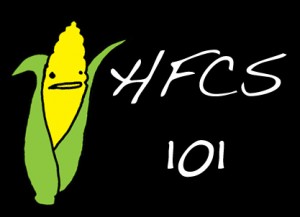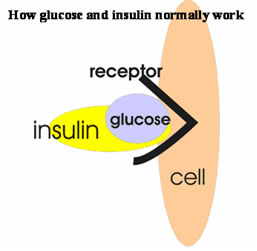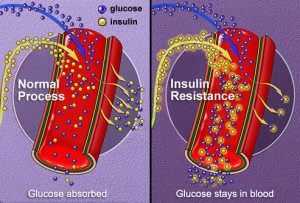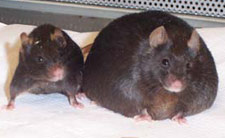HFCS 101 – Intro. to the Biology of High Fructose Corn Syrup
 2012 has been the year of High Fructose Corn Syrup. As the debate rages on, you may be tempted to persuade your family & friends not to eat the stuff (especially considering UCLA’s recent study). If this is the case, you need to have a convincing argument. Not just alarmist rhetoric, but cold hard facts. This is why I have written HFCS 101. It presents the most basic biology behind why the sweetener presents health risks. With this knowledge, you’ll finally be able to convince your mom to put the ice cream down while she is getting her nightly fix of America’s Next Top Model.
2012 has been the year of High Fructose Corn Syrup. As the debate rages on, you may be tempted to persuade your family & friends not to eat the stuff (especially considering UCLA’s recent study). If this is the case, you need to have a convincing argument. Not just alarmist rhetoric, but cold hard facts. This is why I have written HFCS 101. It presents the most basic biology behind why the sweetener presents health risks. With this knowledge, you’ll finally be able to convince your mom to put the ice cream down while she is getting her nightly fix of America’s Next Top Model.
Before I begin, please note that I am NOT advocating the use of other sweeteners over HFCS. While it is true that HFCS has some uniquely unenviable biological consequences, consumption of ‘added sugar’ in general presents little by way of health benefits (understand what is considered an ‘added sugar’).
I’ll start this ‘lesson’ with the absolute basic principle – HFCS has more fructose than normal table sugar. Most often, it contains 55% fructose & 45% glucose (compared to 50/50 in table sugar). However, it can sometimes be composed of up to 90% fructose. In these sections, I talk about the differences in the way fructose is digested compared to glucose in the body. These effects are amplified when HFCS is consumed.
Now to the biology (yes!) -
1. Fructose is digested into fat much easier than glucose.
When HFCS/sugar are consumed, the fructose and glucose molecules are absorbed at the intestines. From there, the body processes these molecules in different pathways.
Glucose: Glucose is processed in an intensely regulated pathway, with insulin being the main regulator. Insulin is a hormone released by the pancreas into our blood, and it is in charge of regulating the amount of glucose in our blood. When we consume glucose, insulin is released. The hormone sends the message to our cells to absorb glucose from the blood through a cell surface transporter called Glut-4. Once glucose has entered the cells, a complex interaction of hormones controls the amount of and the rate at which glucose is converted into fat.
hormone released by the pancreas into our blood, and it is in charge of regulating the amount of glucose in our blood. When we consume glucose, insulin is released. The hormone sends the message to our cells to absorb glucose from the blood through a cell surface transporter called Glut-4. Once glucose has entered the cells, a complex interaction of hormones controls the amount of and the rate at which glucose is converted into fat.
versus
Fructose: Fructose is processed in a pathway independent of insulin. Instead of being absorbed into the cells through the Glut-4 transporter, it is actually absorbed through a transporter called Glut-5 (I know, what a stark difference). This transporter is not controlled by insulin, so once fructose is in the blood, it is absorbed into the cells with little regulation. Once in the cells, fructose is quickly cut in half by an enzyme, turning it into two molecules that are the direct precursors of fat molecules. These molecules are quickly turned to fat, and voila, our blood suddenly has significantly elevated fat levels (much more so than what could be achieved by glucose.)
So what is the issue with fat in the blood?
Well, this may seem relatively intuitive. More fat in the blood means obesity, clogged arteries, heart disease etc. But what you may not have known is that this condition is also correlated with a higher risk of insulin resistance, which means that your cells stop responding to insulin’s messages about glucose absorption. When insulin resistance becomes serious, it is called Type 2 Diabetes.
2. Fructose does NOT signal to the body that we are nourished, while glucose does.
When we consume any from of carbohydrate (sugar molecules), it makes sense that our bodies should realize that they have received nourishment. That’s where HFCS bucks the trend.
Glucose: As I mentioned earlier, when glucose is consumed, insulin hormone is released. Along with telling cells to absorb glucose, insulin directly regulates another hormone, leptin. Leptin is in charge of regulating hunger. When insulin concentrations in our blood increase, so do leptin concentrations. This spike in leptin signals to the body that it has been nourished, and it does not need to eat more. Furthermore, the brain can absorb glucose because the brain’s cells have that infamous Glut-4 transporter. When glucose is absorbed, the brain realizes we have consumed nutrients, and it reduces our hunger.
versus
Fructose: Fructose is the anti-glucose in this comparison. When fructose is consumed, insulin is not released (because insulin cannot regulate fructose absorption). Since insulin is not released, leptin is also not released. The lack of leptin means that when fructose is consumed, the body does not get the message that it has been satiated, so we will just keep on eating (and we know what that leads to). Furthermore, the brain CANNOT absorb fructose molecules because it lacks the Glut-5 transporter. Thus, when fructose is consumed, the brain does not send out signals to the body to stop eating!
So what is the issue with over-eating?
I am not really sure if I need to answer this question. But for your assurance, I will provide you with this fact. Studies have shown that people whose bodies cannot create the hormone leptin are extremely obese. Thus, consuming excessive amounts of fructose, a molecule that does not induce leptin secretion, cannot be good for our health.
Summary
High Fructose Corn Syrup has consistently associated with a higher risk of metabolic syndrome. Metabolic syndrome is a general term for a cluster of health issues, including obesity, excessive insulin in the blood, elevated fat in the blood, and elevated blood pressure. To learn more about HFCS’s impacts on health, check out FoundHealth’s articles on HFCS & Hypertension/ Heart Disease/ Diabetes/ Autism.
If you would like to learn more/see references, click on any of my HFCS & Heath Challenge articles above. References are included there.
24 Responses to HFCS 101 – Intro. to the Biology of High Fructose Corn Syrup
Leave a Reply to Gail Cancel reply
Your email address will not be published. Required fields are marked *
*
*
You may use these HTML tags and attributes: <a href="" title=""> <abbr title=""> <acronym title=""> <b> <blockquote cite=""> <cite> <code> <del datetime=""> <em> <i> <q cite=""> <strike> <strong>
Join Our Community
Archives
- January 2023
- December 2022
- September 2022
- August 2022
- June 2022
- May 2022
- April 2022
- March 2022
- February 2022
- January 2022
- December 2021
- November 2021
- October 2021
- September 2021
- August 2021
- July 2021
- June 2021
- May 2021
- March 2021
- September 2020
- August 2020
- July 2020
- June 2020
- May 2020
- April 2020
- March 2020
- February 2020
Subscribe

Sign up to receive FREE toolkit
From Dr. Hyman, #1 NY Times & Amazon Author
We never spam or sell your e-mail









Very nice explanations. These are the reasons why we need to remove fructose in our diet. It cause lots of health problems that concerns many health experts. With the researched they made, it is clear that fructose is not safe. It is more dangerous than sugar like what this article said about fructose http://articles.mercola.com/sites/articles/archive/2010/01/02/highfructose-corn-syrup-alters-human-metabolism.aspx
[...] Read the blog. [...]
Fructolysis does not yield two identical trioses. It yields two different molecules, although they can both end up as glyceraldehyde-3-phosphate (while being processed in the liver), and ultimately can be turned into triglyceride. Let’s be a lot more careful with our facts here. If you putzed one claim, what else did you get wrong? It doesn’t help the cause to lie about technical details.
Hi Michael-
That was a mistake on my part (not a deliberate lie), but I did my best to cover the main points without digging deep into details. Though attention to detail is fundamental to biology, detail isn’t helpful to untrained audiences. Thanks for the critical eye.
Is this information being used in junior high, and high school health classes? Is a healthy path going to be to educate instead of legislate? I understand and vote with my $$. How does this get from being preached to the choir, to mainstream consciousness?
Hi Paul-
I think this information should be taught in schools, but it also presents challenges. A large proportion of food that schools serve is processed, which means that a lot of it will contain HFCS. Before schools can really start advocating against HFCS, shouldn’t they replace it in the cafeterias? The money to make this happen in schools is not there, which is unfortunate. These are just my sentiments, I’m interested to know your thoughts.
For now, keep telling your friends and family about why you limit HFCS consumption. I have a lot of friends who are starting to be more conscious because of my advocacy. I bet you’ll find similar results.
Part of the problem is that corn is highly subsidized by the U.S. government. This makes corn products like HFCS extremely cheap to make, therefore making more likely that the tight budget of the average school cafeteria will buy something that contains it. Not to mention the “competitive foods” in vending machines that bring the schools some needed cash are full of the stuff.
Something struck me while reading this. What is the fructose content of honey, agave, maple,and other liquids/syrups? Also, since most table sugar is made from cane, could the high fructose content simply be due to the fact it’s corn, and that corn is GMO in most cases? Has there been any exploration into this?
Hi Cynthia-
I can’t answer your questions off the top of my head, and I don’t have the bandwidth to research right now! I’ll try to respond when I can. I am sure you’ll be able to find this info online relatively easily though!
Thanks for reading!
This is a perfect explanation of why too much fructose is bad for you and can lead to weight gain, but the problem is, HFCS’s ratio of fructose to glucose is not only inconsistent in real-life applications, but natural sweeteners like agave syrup have been found to have more fructose to glucose than the two most popular types of HFCS. Plus, there are three kinds of HFCS with different ratios, one of which is less fructose than glucose. So to me, this is not a compelling argument for why HFCS is worse than other sweeteners, just why too much fructose is bad. I am not a fan of HFCS, largely because it’s so significantly processed, it’s in EVERYTHING because it’s so cheap, and it’s genetically modified, but I don’t feel like this argument is going to cut it. Thank you, nonetheless, for putting this information out there; it is important. And feel free to correct me if I am wrong about any of this…I’m also searching for the truth.
Hi Alexandra-
I am not an expert on all things sweeteners, so I won’t claim to be one. Regardless, here are my thoughts:
I think the key point here is not that HFCS is the single most detrimental sweetener, but that when we account for its unparalleled prevalence in our diets AND its excessively detrimental health effects, HFCS is having an unrivaled impact on the health of country. If we raise awareness on HFCS, hopefully people will start reading labels and will start steering clear of it, and as a byproduct, will start steering clear of processed foods all together.
That being said, if tomorrow we replace all HFCS containing products with table sugar and we maintain our dietary habits, we will NOT get healthier as a society. Though the biology shows that sugar is not as bad, it is NOT good. Furthermore, if we replace HFCS with something like agave syrup that has more fructose, we will definitely not get healthier!
With that said, foods would also get more expensive with these products, because they aren’t as heavily subsidized as HFCS (I think..). So maybe we would eat less processed foods because of the price.
In the end, eating too much sweetener of any sort is terrible. However, HFCS is seriously hurting the country, and if we want to encourage people to steer clear, we need to be able to explain why. That’s the purpose of the article.
Alexandra; HFCS is so cheap due to the subsidizing by the US Gov. to keep money away from the Cuba sugar companies.
Vsingh; Thanks for the article. I was linked her by a friend and she missed one of the major points. (I’m used to her emo reactions to titles and headings) TOO MUCH of anything isn’t good for you.
mike
It’s not news that Americans eat more sugar than the should. I mean it’s not as if we’re not aware that we’re #1 in otbisey but infographics like this are less meaningful when you don’t look at our overall consumption of food. More disgusting is that the bottom 4/5ths of that dumpster is a sloshing mess of corn syrup. That dumpster of sugar would be parked behind an apartment tenement made of chicken pork and beef. I’d be much more interested in how many dumpsters we fill of ingredients that don’t occur in nature, red dye, preservatives, artificial flavoring, MSG, reconstituted food products.
[...] you are curious about more HFCS facts, there are several great articles here. Plus a great infographic that breaks it down [...]
Good to know – I recently switched to agave because Dr. Oz said on his show, it was better…. I’m really working hard to eliminate all sugars but it’s not easy! Thanks for the great information!
fructose from a fruit are found to react differently in the body?
My initial post was cut.
Great explanation. I’m wondering if differences in HFCS and fructose from a fruit are found to respond differently in the body.
Please inform about fructose from real fruit. Is it also as bad?
Great introductory ‘class’!
Keep up the good work (and awesome graphics) and hopefully we’ll all be able to spread the word to help educate and retrain our country (and our taste buds!).
Thanks Jana! Your kind words make me feel like it was worth the time!
[...] HFCS 101-Intro to the biology of high fructose corn syrup [...]
[...] true that HFCS has some uniquely unenviable biological consequences (which I chronicle in detail here), consumption of ‘added sugar’ in general presents NO health benefits (understand what is [...]
I am a consultant to the Corn Refiner’s Association but my opinions about sugar and HFCS are my own. This article should really be titled “Fructose 101″. Fructose acts differently in the absence of glucose. So you can’t compare studies using pure fructose (which we rarely consume) to the foods we do eat that contain sucrose or HFCS. The ‘extra’ fructose in HFCS is not significant compared to sucrose. You are absolutely correct: We should be consuming less added sugars in general, but singling out HFCS is misguided. Using Agave as an alternate sugar is really misguided if anyone is concerned about fructose (since it is about 75% fructose). See more sugar science here from the science community itself: http://issuu.com/sweetenerinfo/docs/science-spotlight-eb2012?mode=window&backgroundColor=%23e9e9e9
Have you read Gut and Psychology Syndrome by Dr. Natasha Campbell McBride? What do you think of her analysis of the effect on the gut bacteria and lining of consuming polysaccharides (of which sucrose is one, but not fructose)?